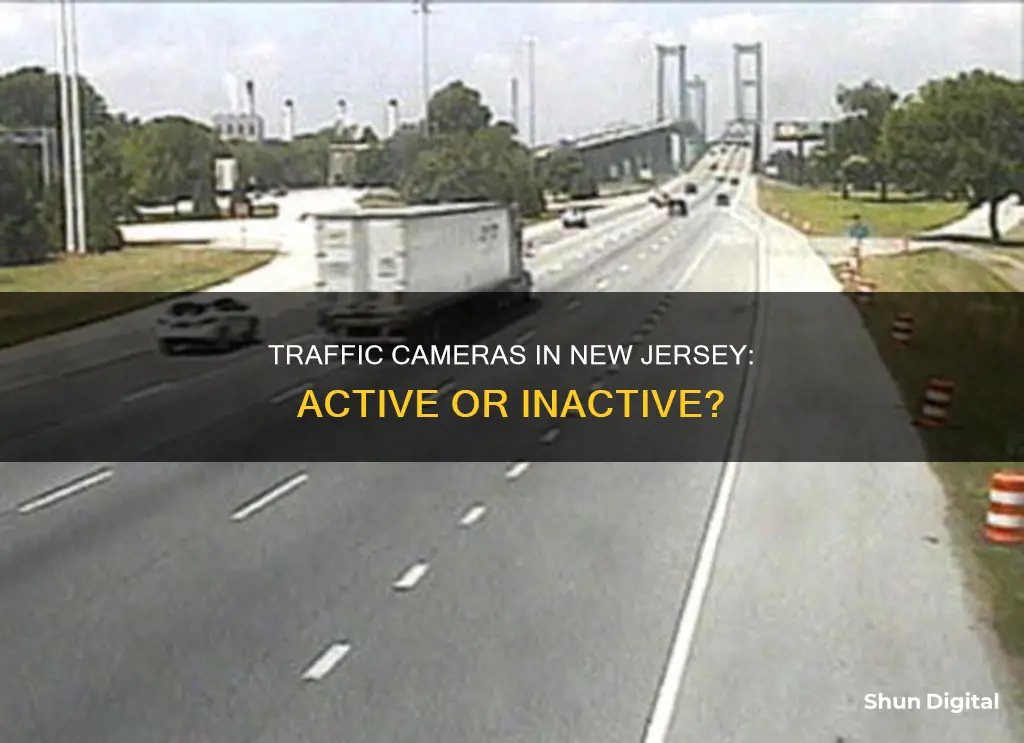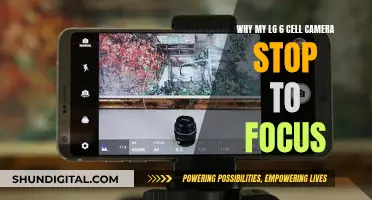
Traffic cameras in New Jersey have been the subject of much discussion and some controversy in recent years. While the state has taken steps to remove inactive cameras, it continues to employ cameras to monitor traffic conditions, manage traffic flow, and handle emergencies. So, are traffic cameras still active in New Jersey?
| Characteristics | Values |
|---|---|
| Red-light cameras | Red-light cameras are not active in New Jersey. The red-light camera pilot program ended in 2014. |
| Traffic cameras | The New Jersey Department of Transportation (NJDOT) uses cameras on state highways to monitor traffic conditions, delays, incidents, and weather conditions. |
| Traffic signal sensors | Cameras are mounted on traffic lights to control signal timing. |
What You'll Learn

Red-light cameras in NJ: history and current status
Red-light cameras are automated tools used by law enforcement to monitor and enforce traffic laws. They capture images of vehicles that run red lights and are typically installed at high-traffic intersections, school zones, and areas with a history of accidents or speeding violations.
History of red-light cameras in New Jersey
New Jersey introduced a special five-year red-light camera program in 2009. This program ended in 2014, much to the relief of drivers. During this time, the cameras were a controversial way for law enforcement to monitor roadways for traffic violations without increasing the number of officers on the roads. The cameras would collect evidence and send automated tickets to the owners of the vehicles, based on license plate information.
Current status
As of 2022, red-light cameras are no longer in use in New Jersey. The program was discontinued due to various reasons, including the fact that tickets were being issued to the registered owners of vehicles, regardless of who was driving at the time of the violation. There were also concerns about the accuracy of the cameras, with some people receiving tickets even when they had not broken any traffic rules.
While red-light cameras are no longer active, there are still many cameras located on state highways and other roads in New Jersey. These cameras are used to monitor traffic flow and conditions and are available for commuters to view on the 511NJ website and telephone service. These cameras do not issue tickets and are placed to help traffic flow as efficiently and safely as possible and to handle emergencies.
Charging the Kitmesh Camera: A Quick Guide
You may want to see also

Traffic cameras and driver privacy
Traffic cameras are an essential component of road safety, helping to monitor and manage traffic flow, handle emergencies, and detect motoring offenses. However, their use also raises important questions about driver privacy.
In recent years, the use of traffic cameras has become widespread, with many American cities installing "red-light camera" systems to capture vehicles running red lights or stop signs. These systems use the vehicle's license plate to look up the owner's address and issue a ticket. While these cameras can improve road safety and reduce accidents, they also present some privacy and fairness concerns.
One of the main issues is that the ticket is sent to the owner of the vehicle, who may not have been the person committing the violation. This shifts the burden of proof onto the owner to prove their innocence, which goes against the fundamental legal principle of innocent until proven guilty. Additionally, there is a potential conflict of interest when private contractors are involved in the ticketing process, as they may have financial incentives to issue more tickets, leading to public cynicism and suspicion.
Another concern is the potential for "mission creep" in the use of data collected by these cameras. Privacy advocates worry that while the cameras may be installed for traffic safety reasons, the data could be used for other purposes, such as tracking vehicle movements and, by extension, the movements of the vehicle owner. This could lead to mass surveillance and an invasion of privacy. This concern is heightened by the fact that surveillance techniques and data banks rarely remain restricted to their original purpose.
To address these privacy and fairness issues, some states and organizations have proposed solutions. For example, the state of New Jersey introduced a bill to protect drivers from being ticketed by red-light cameras outside of the state, preventing the sharing of driver information for these types of summonses. Additionally, some driver monitoring solutions (DMS) providers have clarified that they do not film drivers continuously and that data is stored with heavy encryption and deleted unless it tracks a specific fatigue event.
In conclusion, while traffic cameras play a crucial role in enhancing road safety and efficiency, it is essential to carefully consider and address the privacy implications they pose to drivers. Striking a balance between utilizing technology for public safety and protecting individuals' privacy rights is key to ensuring a fair and secure environment for all road users.
The Focusing Stick: Fujifilm's Unique Feature Explained
You may want to see also

Traffic cameras and road safety
Traffic cameras are an essential tool for improving road safety and reducing accidents. They can be used to monitor and enforce safe driving practices, such as compliance with speed limits, red lights, and other road rules. By capturing photographic or video evidence of vehicles violating these rules, traffic cameras can help identify and penalize offenders, deterring future violations and improving overall road safety.
The effectiveness of traffic cameras in enhancing road safety has been demonstrated in numerous studies. Research by the Insurance Institute for Highway Safety found that traffic cameras reduced red-light violations by 40% at intersections where they were installed. Additionally, the same study showed a 24% decrease in fatal accidents caused by red-light violations in cities with traffic cameras. This is further supported by a UK Department for Transport estimate, which concluded that cameras led to a 22% reduction in personal injury collisions and a 42% decrease in fatalities or severe injuries at camera sites.
In Seattle, the implementation of traffic cameras resulted in a notable 30% reduction in red-light violations and a substantial 42% decrease in accidents caused by such violations. Similarly, in Chicago, the utilization of traffic cameras led to a significant 19% drop in fatal accidents attributed to red-light violations. These statistics emphatically emphasize the positive impact of traffic cameras on road safety.
Traffic cameras can be deployed in various forms, including fixed units, point-to-point units, and mobile units, each targeting specific locations or capturing average speeds over certain distances. The selection of the appropriate type depends on factors such as the scope and location of the problem, the variation in speeds at enforcement sites, and the need for overt or covert enforcement.
While traffic cameras offer significant benefits, there are also challenges to their implementation. One prominent challenge is the cost associated with installing and maintaining the cameras. Additionally, there are concerns about the potential misuse of traffic cameras as revenue-generating tools rather than safety measures. It is crucial to address these challenges by setting clear guidelines, monitoring the use of cameras, and exploring alternative funding sources to ensure the primary focus remains on enhancing road safety.
In conclusion, traffic cameras play a vital role in promoting road safety and reducing accidents. Their effectiveness has been proven through research and real-world examples. By addressing the challenges and maximizing the benefits of traffic cameras, we can create safer and more efficient roads for all road users, from drivers to pedestrians and cyclists.
Polaroid Tablets: Any Relation to Iconic Polaroid Cameras?
You may want to see also

Traffic cameras and traffic flow
Traffic cameras are an essential part of city infrastructure, helping to improve traffic flow and road safety. These cameras are typically mounted on poles, bridges, or other structures, and are placed at intersections, on-ramps, and other points where traffic congestion is likely to occur. They are often connected to a control centre or network, allowing traffic engineers and law enforcement personnel to monitor traffic flow, detect accidents, and take appropriate action.
The New Jersey Department of Transportation (NJDOT) uses cameras on state highways to help manage traffic flow and handle emergencies. The 511NJ website provides an extensive list of camera locations, allowing commuters to check for incidents, accidents, congestion, and events like weather and construction before leaving home.
Traffic cameras can also be equipped with sensors to detect vehicle speed, enabling authorities to enforce speed limits and issue tickets to speeding drivers. For example, the Insurance Institute for Highway Safety (IIHS) found that intersections without red-light cameras are 30% more likely to have fatal red-light-running crashes.
In addition to improving safety, traffic cameras can also aid in city planning and data gathering. The data collected by these cameras can be used to create better road plans and develop new traffic management strategies. For instance, by analysing real-time traffic data, bottlenecks can be identified, and traffic can be redirected to improve efficiency and reduce carbon emissions.
Furthermore, with the integration of artificial intelligence, traffic cameras can offer advanced capabilities such as object detection and classification. This enables the detection of wrong-way driving, stationary vehicles, and other dangerous situations, triggering alerts to prevent accidents.
While traffic cameras have multiple benefits, it's important to respect privacy concerns. Low-resolution cameras that cannot perform license plate or facial recognition can be utilised to balance privacy and security.
In conclusion, traffic cameras play a crucial role in managing traffic flow and enhancing road safety. With the support of advanced technologies, these cameras contribute to smarter and more efficient transportation systems, ultimately improving the driving experience for motorists.
Surveillance Cameras: Live Viewing and Remote Monitoring
You may want to see also

Traffic cameras and emergency response
Traffic cameras are an essential component of modern road safety and emergency response systems. They play a crucial role in enhancing the efficiency and effectiveness of emergency response coordination. Here's how:
Real-time Situational Awareness:
Traffic cameras provide emergency responders and decision-makers with real-time visual information about incidents, accidents, congestion, and road conditions. This situational awareness enables them to coordinate a swift and appropriate response, minimizing disruptions and maximizing public safety.
Efficient Emergency Response:
By offering a live feed of the scene, traffic cameras help emergency dispatchers and responders assess the severity of a situation promptly. This includes determining the need for medical assistance, extrication, or other resources. With this information, emergency services can reduce response times and minimize the impact of accidents or incidents.
Emergency Vehicle Management:
Traffic cameras also aid in optimizing routes for emergency vehicles. By monitoring traffic flow and providing real-time updates, emergency responders can select the fastest routes, bypassing congested areas and reaching their destinations more quickly. This is particularly crucial for ambulances, where timely response can mean the difference between life and death.
Incident Investigation and Documentation:
In the event of an accident or incident, traffic camera footage serves as invaluable evidence. It assists authorities in reconstructing the sequence of events, determining fault, and identifying contributing factors. This not only expedites insurance claims but also guides safety improvements to prevent similar occurrences in the future.
Law Enforcement and Deterrence:
Traffic cameras aid in enforcing traffic laws by capturing violations such as speeding, running red lights, or reckless driving. This helps hold offenders accountable and encourages motorists to obey traffic regulations, fostering a culture of safer driving. The presence of cameras can act as a deterrent, reducing the incidence of traffic violations and enhancing overall road safety.
While the benefits of traffic cameras in emergency response are significant, it is essential to balance these advantages with legitimate concerns about privacy, data accuracy, and financial implications. Responsible deployment and management of traffic camera systems are necessary to maximize their positive impact on emergency response capabilities.
Unlocking the Secrets of Free Camera Mode
You may want to see also
Frequently asked questions
The New Jersey Department of Transportation (NJDOT) maintains traffic cameras on many interstates and other New Jersey State highway systems. These cameras are typically mounted on poles and are used to monitor traffic conditions, delays, incidents, and weather conditions. They are monitored 24/7 at the NJDOT's Statewide Traffic Management Center.
The primary purpose of these cameras is to help manage traffic flow, ensure safety, and facilitate emergency response.
Yes, the NJDOT has cameras on state highways and interstate highways like the New Jersey Turnpike and the Garden State Parkway. You can find a list of camera locations and view real-time traffic conditions on the 511NJ website or by dialling 511.
No, the red-light camera pilot program ended in 2014, and there are no plans to bring it back. Any remaining cameras from that program are non-operational and are in the process of being removed.
While there are no indications of new traffic cameras being introduced, New Jersey did receive a "caution" grade from a national safety group for lacking certain safety laws, including the use of red-light and speed cameras. However, it's important to note that speed cameras are currently illegal in New Jersey.







